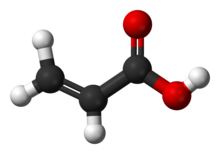Acrylic acid

| |

| |
| Names | |
|---|---|
| IUPAC name
Acrylic acid[2]
| |
| Preferred IUPAC name
Prop-2-enoic acid[2] | |
Other names
| |
| Identifiers | |
3D model (JSmol)
|
|
| 635743 | |
| ChEBI | |
| ChEMBL | |
| ChemSpider | |
| DrugBank | |
| ECHA InfoCard | 100.001.071 |
| EC Number |
|
| 1817 | |
| KEGG | |
PubChemCID
|
|
| RTECS number |
|
| UNII | |
CompTox Dashboard(EPA)
|
|
| |
| |
| Properties | |
| C3H4O2 | |
| Molar mass | 72.063g/mol |
| Appearance | Clear, colorless liquid |
| Odor | Acrid[3] |
| Density | 1.051g/mL |
| Melting point | 14 °C (57 °F; 287 K) |
| Boiling point | 141 °C (286 °F; 414 K) |
| Miscible | |
| logP | 0.28[4] |
| Vapor pressure | 3mmHg[3] |
| Acidity(pKa) | 4.25 (H2O)[5] |
| Viscosity | 1.3cPat 20 °C (68 °F) |
| Hazards | |
| GHSlabelling: | |
    
| |
| Danger | |
| H226,H302,H312,H314,H332,H400 | |
| P210,P233,P240,P241,P242,P243,P260,P261,P264,P270,P271,P273,P280,P301+P312,P301+P330+P331,P302+P352,P303+P361+P353,P304+P312,P304+P340,P305+P351+P338,P310,P312,P321,P322,P330,P363,P370+P378,P391,P403+P235,P405,P501 | |
| NFPA 704(fire diamond) | |
| Flash point | 49.4[6]°C (120.9 °F; 322.5 K) |
| 429 °C (804 °F; 702 K) | |
| Explosive limits | 2.4–8.02%[3] |
| NIOSH(US health exposure limits): | |
PEL(Permissible)
|
None[3] |
REL(Recommended)
|
TWA 2ppm (6mg/m3) [skin][3] |
IDLH(Immediate danger)
|
N.D.[3] |
| Safety data sheet(SDS) | MSDS |
| Related compounds | |
Otheranions
|
acrylate |
Relatedcarboxylic acids
|
acetic acid propionic acid lactic acid 3-hydroxypropionic acid malonic acid butyric acid crotonic acid |
Related compounds
|
allyl alcohol propionaldehyde acrolein methyl acrylate |
Except where otherwise noted, data are given for materials in theirstandard state(at 25 °C [77 °F], 100 kPa).
| |
Acrylic acid(IUPAC:prop-2-enoic acid) is anorganic compoundwith the formula CH2=CHCOOH. It is the simplestunsaturatedcarboxylic acid,consisting of avinyl groupconnected directly to acarboxylic acidterminus. This colorless liquid has a characteristic acrid or tart smell. It ismisciblewithwater,alcohols,ethers,andchloroform.More than a million tons are produced annually.[7]
History
[edit]The word "acrylic" was coined in 1843, for a chemical derivative ofacrolein,an acrid-smelling oil derived fromglycerol.
Production
[edit]Acrylic acid is produced byoxidationofpropylene,which is a byproduct of the production ofethyleneand gasoline:
- 2 CH2=CHCH3+ 3 O2→ 2 CH2=CHCO2H + 2 H2O
Historical methods
[edit]Because acrylic acid and its esters have long been valued commercially, many other methods have been developed. Most have been abandoned for economic or environmental reasons. An early method was thehydrocarboxylationof acetylene ( "Reppechemistry "):
This method requiresnickel carbonyl,high pressures ofcarbon monoxide,and acetylene, which is relatively expensive compared to propylene.
Acrylic acid was once manufactured by thehydrolysisofacrylonitrile,a material derived frompropeneby ammoxidation, but this route was abandoned because it cogenerates ammonium side products, which must be disposed of. Other now abandoned precursors to acrylic acid includeethenoneand ethylene cyanohydrin.[7]
Research
[edit]Carboxylatingethylene to acrylic acid undersupercritical carbon dioxideis thermodynamically possible, but efficient catalysts have not been developed.[8]3-Hydroxypropionic acid(3HP), an acrylic-acid precursor by dehydration, can be produced from sugars, but the process is not competitive.[9][10]
Reactions and uses
[edit]Acrylic acid undergoes the typicalreactions of a carboxylic acid.When reacted with analcohol,it forms the correspondingester.The esters andsaltsof acrylic acid are collectively known asacrylates(or propenoates). The most common alkyl esters of acrylic acid aremethyl,butyl, ethyl, and 2-ethylhexyl acrylate.
Acrylic acid and its esters readily combine with themselves (to formpolyacrylic acid) or othermonomers(e.g.acrylamides,acrylonitrile,vinylcompounds,styrene,andbutadiene) by reacting at their double bond, forminghomopolymersorcopolymers,which are used in the manufacture of variousplastics,coatings,adhesives,elastomers,as well as floor polishes and paints.
Acrylic acid is used in many industries, including thediaperindustry, thewater treatmentindustry, and thetextileindustry. The annual worldwide consumption of acrylic acid is projected to reach more than an estimated 8,000 kilotons by 2020. This increase is expected due to its use in new applications, includingpersonal careproducts,detergents,and products for adultincontinence.[11]
Substituents
[edit]As a substituent acrylic acid can be found as anacyl groupor a carboxyalkyl group, depending on the removal of the group from the molecule.
More specifically, these are:
- Theacryloyl group,with the removal of the −OH from carbon-1.
- The2-carboxyethenyl group,with the removal of a −H from carbon-3. This substituent group is found inchlorophyll.
Safety
[edit]Acrylic acid is severely irritating and corrosive to the skin and the respiratory tract. Eye contact can result in severe and irreversible injury. Low exposure will cause minimal or no health effects, while high exposure could result inpulmonary edema.TheLD50is 340 mg/kg (rat, oral) with the lowest recordedLD50being 293 mg/kg (oral, rat) comparable to ethylene glycol which is indicative of being a potent poison.[12]Ethyl acrylate was once used as synthetic food flavoring and was withdrawn by FDA possibly due to cancerogenic effects observed in lab animals.[13]
Animal studies showed that high-doses of acrylic acid decreased weight gain. Acrylic acid can be converted to non-toxiclactic acid.[14]
Acrylic acid is a constituent oftobacco smoke.[15]
See also
[edit]References
[edit]- ^Merck Index,11th Edition,124.
- ^abInternational Union of Pure and Applied Chemistry(2014).Nomenclature of Organic Chemistry: IUPAC Recommendations and Preferred Names 2013.The Royal Society of Chemistry.p. 746.doi:10.1039/9781849733069.ISBN978-0-85404-182-4.
- ^abcdefNIOSH Pocket Guide to Chemical Hazards."#0013".National Institute for Occupational Safety and Health(NIOSH).
- ^"Acrylic acid_msds".
- ^Dippy, J. F. J.; Hughes, S. R. C.; Rozanski, A. (1959). "The dissociation constants of some symmetrically disubstituted succinic acids".Journal of the Chemical Society:2492–2498.doi:10.1039/JR9590002492.
- ^"ACRYLIC ACID, STABILIZED".Office of Response and Restoration.Retrieved19 August2024.
- ^abOhara, Takashi; Sato, Takahisa; Shimizu, Noboru; Prescher, Günter; Schwind, Helmut; Weiberg, Otto; Marten, Klaus; Greim, Helmut (2003). "Acrylic Acid and Derivatives".Ullmann's Encyclopedia of Industrial Chemistry.Weinheim: Wiley-VCH.doi:10.1002/14356007.a01_161.pub2.ISBN3527306730.
- ^Sakakura, Toshiyasu; Choi, Jun-Chul; Yasuda, Hiroyuki (13 June 2007). "Transformation of Carbon dioxide".Chemical Reviews.107(6): 2365–2387.doi:10.1021/cr068357u.PMID17564481.
- ^Sweet Deal: Dow and Partner Cook up Sugar-to-Acrylic Plan.Durabilityanddesign.com. Retrieved on 2012-05-24.
- ^Better Bugs to Make Plastics, Technology Review, September 20, 2010, retrieved January 9, 2012.Technologyreview.com (2010-09-20). Retrieved on 2012-05-24.
- ^"Acrylic acid market".Retrieved2018-05-30.
- ^"Webwiser Acrylic Acid".
- ^"Synthetic food flavorings law update".
- ^"Provisional Peer-Reviewed Toxicity Values for Acrylic Acid"(PDF).www.google.com.Retrieved2022-04-29.
- ^Talhout, Reinskje; Schulz, Thomas; Florek, Ewa; Van Benthem, Jan; Wester, Piet; Opperhuizen, Antoon (2011)."Hazardous Compounds in Tobacco Smoke".International Journal of Environmental Research and Public Health.8(12): 613–628.doi:10.3390/ijerph8020613.ISSN1660-4601.PMC3084482.PMID21556207.


